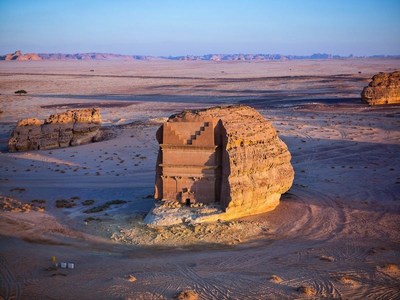Royal Commission for Al-Ula Launches Archaeology Programme in Al-Ula
Comunicato Precedente

Comunicato Successivo

(Photo: https://mma.prnewswire.com/media/685113/Al_Ula.jpg )
The Royal Commission for Al-Ula was established in July 2017 to protect and preserve the region's extraordinary ancient heritage and natural landscapes and prepare for an era of renewed international collaboration and tourism coinciding with the goals of Vision 2030.
Home to dramatic desert landscapes, spectacular rock formations and some of the Middle East's most significant ancient sites, including those built by Lihyanite and Nabataean civilisations of the 1st millennium BCE and beyond, Al-Ula is a wonder of the ancient Arabian world.
State of the Art Technology
Using state-of-the-art technologies and methods, such as aerial LiDAR scanning and photography captured from light aircraft, helicopter and drone, a team of world-leading experts, led by RCU archaeologist Dr Rebecca Foote, will meticulously document, map and model the area, supporting RCU's mission to uncover Al-Ula's ancient secrets and mysterious past. Capable of recording surface features through vegetation, the LiDAR, for example, will 'see' what lies amongst the palm groves of the oasis, and the helicopter team will record the remote and harder to reach sites.
Thoroughly documenting the area will provide a better understanding of these incredible cultural heritage sites and their ancient past, something that is vital to safeguarding it for future generations. Providing a window into the people and cultures that shaped the past, the findings will be collated in a bespoke heritage database (Arches) and used by RCU to develop a plan for preserving, studying and activating the area's unique features.
The RCU archaeological survey programme supports the Commission's mission to protect and develop the heritage and historical sites of Al-Ula in order to achieve a sustainable transformation and to enable local, regional and international visitors to learn about the richness of its cultural, historical and natural heritage.
Combined Local and International Expertise
Situated at a historic nexus of civilisations, on an important route of travel used from at least the first millennium BCE for the trade of valuable commodities such as frankincense and myrrh, Al-Ula is built on a history of exchange between cultures.

This exchange of knowledge and cultures goes back millennia and continues to be a crucial part of the area's identity, and is a blueprint for its future. Taking a collaborative approach, RCU is working with international and local archaeologists, including teams from the UK, France, Australia and KSA. As part of the Royal Commission's programme, students from King Saud University are being trained by expert archaeologists in international best practice, equipping them with the skills to become the next generation of cultural custodians for Al-Ula.
Dr Rebecca Foote, Head of Heritage & Archaeology, Royal Commission for Al-Ula said:
"At the heart of the Royal Commission for Al-Ula's archaeology programme is a commitment to preserving Al-Ula's extraordinary cultural heritage sites for generations to come. Our work observes international best practice standards and utilises some of the most sophisticated technology available. The public closure of sites such as Mada'in Salih will allow us to carry out vital work locating, mapping and visualising Al-Ula's past in order to evaluate vulnerabilities and implement appropriate protective interventions throughout the area."
NOTES TO EDITORS
About Al-Ula
Located 1,100 km from Riyadh, in North-West Saudi Arabia, Al-Ula is a place of extraordinary natural and human heritage. The vast area, covering 22,561km², includes a lush oasis valley, towering sandstone mountains and ancient cultural heritage sites dating back thousands of years to when the Lihyan and Nabataean kingdoms reigned.
The most well-known and recognised site in Al-Ula is Mada'in Salih, Saudi Arabia's first UNESCO World Heritage Site. A 52-hectare ancient city, Mada'in Salih was the principal southern city of the Nabataean Kingdom and is comprised of more than 100 well preserved tombs with elaborate facades cut out of the sandstone outcrops surrounding the walled urban settlement. Current research suggests Mada'in Salih was the most southern outpost of the Roman Empire after conquering the Nabataeans in 106 CE.
In addition to Mada'in Salih, Al-Ula is home to a series of fascinating historical and archaeological sites such as: Al-Khuraybah (ancient Dadan), the capital of the Dadan and Lihyan Kingdoms, which is considered one of the most developed 1st-millennium BCE cities of the Arabian Peninsula; thousands of ancient rock art sites and inscriptions; and Hijaz Railway stations.
About Royal Commission for Al-Ula
The Royal Commission for Al-Ula (RCU) was established by royal decree in July 2017 to protect and safeguard Al-Ula, a region of outstanding natural and cultural significance in North-West Saudi Arabia. RCU is embarking on a long-term plan to develop and deliver a sensitive, sustainable transformation of the region, reaffirming it as one of country's most important archaeological and cultural destinations and preparing it to welcome visitors from around the world. RCU's development work in Al-Ula encompasses a broad range of initiatives across archaeology, tourism, culture, education and the arts, reflecting the ambitious commitment to cultivate tourism and leisure in Saudi Arabia, outlined in Vision 2030.
For any media enquiries please contact Nora Sankour, Hadath Group | [email protected], +971-568-797-444





